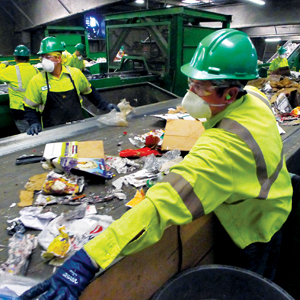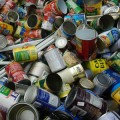The smell is not what I’d expected from a facility processing more than 55 tons of solid waste per hour. The din is, though: the rumble of diesel engines, the drone of conveyor belts headed in every direction, the thunder of massive mechanical separators and sorters. But despite all the refuse being shuffled around, the odor isn’t too bad, just a faintly sour scent mixed with a whiff of exhaust fumes.
That’s only fitting. At GreenWaste’s San Jose facility, which boasts the nation’s highest recovery rate among garbage processors, garbage is a dirty word. Three-fourths of all materials that enter the facility, via curbside bins from throughout Santa Clara, Santa Cruz and San Mateo counties, never actually go to a landfill. Where other processors often divert only 20 to 30 percent of incoming trash, GreenWaste uses advanced sorting techniques—and sheer tenacity—to compost or recycle approximately three times that amount.
Equally impressive is its recycling recovery rate: 98 percent of the tonnage that arrives for recycling goes out the door bundled and ready for sale.
These were mere numbers until I heard the roar of it all working and saw the blur of trash from tens of thousands of homes rushing by. My tour began on the “tipping floor,” where collection trucks empty their loads. A manual floor-sort pulls out wood, metal, rigid plastics and bulky nonrecyclable items before the remainder is sent on its way: onto a conveyor belt, through a metering device that levels out the flow, and upstairs to a station where 20 workers in orange vests sort materials cascading by on three separate conveyors, their hands moving faster than my eyes can follow.
Here, the trash line meets the recycling line, which starts its journey in a similar fashion downstairs on a separate tipping floor. The fact that they’re running side-by-side is no small detail. Few other solid-waste processing facilities in the country are similarly designed, and the proximity of the two lines increases efficiency and capacity while allowing for myriad opportunities to transfer materials from one to the other. Completely overhauled for dual-stream processing in 2008, the 100,000-square-foot facility processes 315 tons of trash and 200 tons of recyclables per day, six days a week.
“There’s such a small fraction of material that can’t be recycled and recovered,” said my tour guide, GreenWaste community-relations manager Emily Hanson. Where there’s a will there’s a way, and GreenWaste’s will is on display. Under a fluorescent glow, sorters on the recycling line are arranged in pairs about 15 feet apart. The first two pull out landfillable garbage, the second get film plastics, the third metals, and the fourth rigid plastics. Occasionally, sorters on the trash line—who are pulling garbage, wood and yard waste, metals, hard plastics and glass—dump a container of recyclable materials onto the belt.
{pagebreak}
From here the trash line passes through a bag breaker that tears open plastic bags, a rotating trommel screen for removing fine organic materials, which looks like a giant front-loading drier, and a drum separator that uses a steady blast of air to blow light plastics and papers off the top of the pile. Materials branch off in every direction as if through the arteries of a massive machine.
By now, the trash stream resembles the incoming recycling stream. But it’s not done. The lightweight materials blown off the top of the conveyor continue through a polishing screen, which separates papers from plastics and other containers. Containers are sorted for recycling, while soiled mixed paper is manually cleaned of inorganics before reaching the end of the line and a trip to the compost facility.
Meanwhile, recyclables are refined by a series of innovative steps. A cardboard separator floats pieces of cardboard above the rest of the materials. Clear plastic bottles are culled from the stream with the aid of a beam of light at the edge of the container belt. Whenever the light is able to shine through a container to a receptor on the other end, it triggers a strong blast of air that forces the plastic straight down into a designated bin. I watched; it works.
Aluminum cans are singled out using another ingenious method: a large magnet beneath a short belt holds them down until just before the end of the line, when a reverse-polarity magnet flings the cans up and off the belt and down a chute four feet away.
“Every kind of plastic that comes through our facility, including film plastic, is recycled,” Hanson told me. “Our recyclery accepts way more items as recyclable materials than any other facility in the area, hands-down. And that means we can do something with it.” Glass, aluminum, and compostable materials are sold locally, while paper, rigid plastics and cardboard often end up in containers headed across the sea to China.
Most of what ultimately goes to the landfill, by weight at least, is furniture, mattresses, carpeting and soiled clothing and rags. These are difficult to recycle, but could’ve potentially been saved from the landfill through donation or reuse.
As much as 80 percent of what’s recovered from the trash line is organic and bound for the compost pile—soiled paper, food scraps, and other debris that breaks down quickly. An adjacent structure houses green waste, where organics from both lines are mixed with yard and tree waste and shipped off to Northern California’s largest composting facility, located in Gilroy and operated by GreenWaste sister company Zanker Road Resource Management.
“The technology pretty much exists for getting close to zero waste,” Hanson said. That’s the goal, after all. Manufacturers will have to make some products easier to recycle, consumers will have to be more careful about that they buy and what they do with it, and recyclers will have to fine-tune some of their processes, but it’s well within reach.

 Food & Wine Events: June 15-22
Food & Wine Events: June 15-22 

